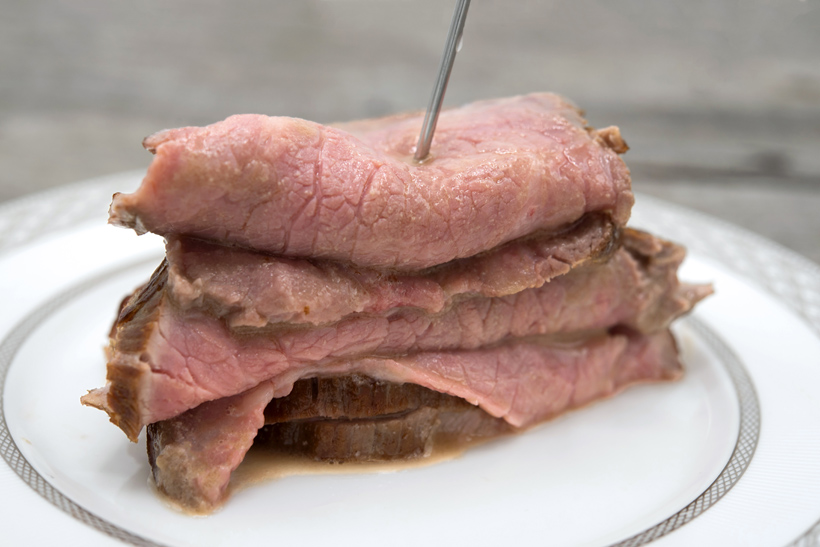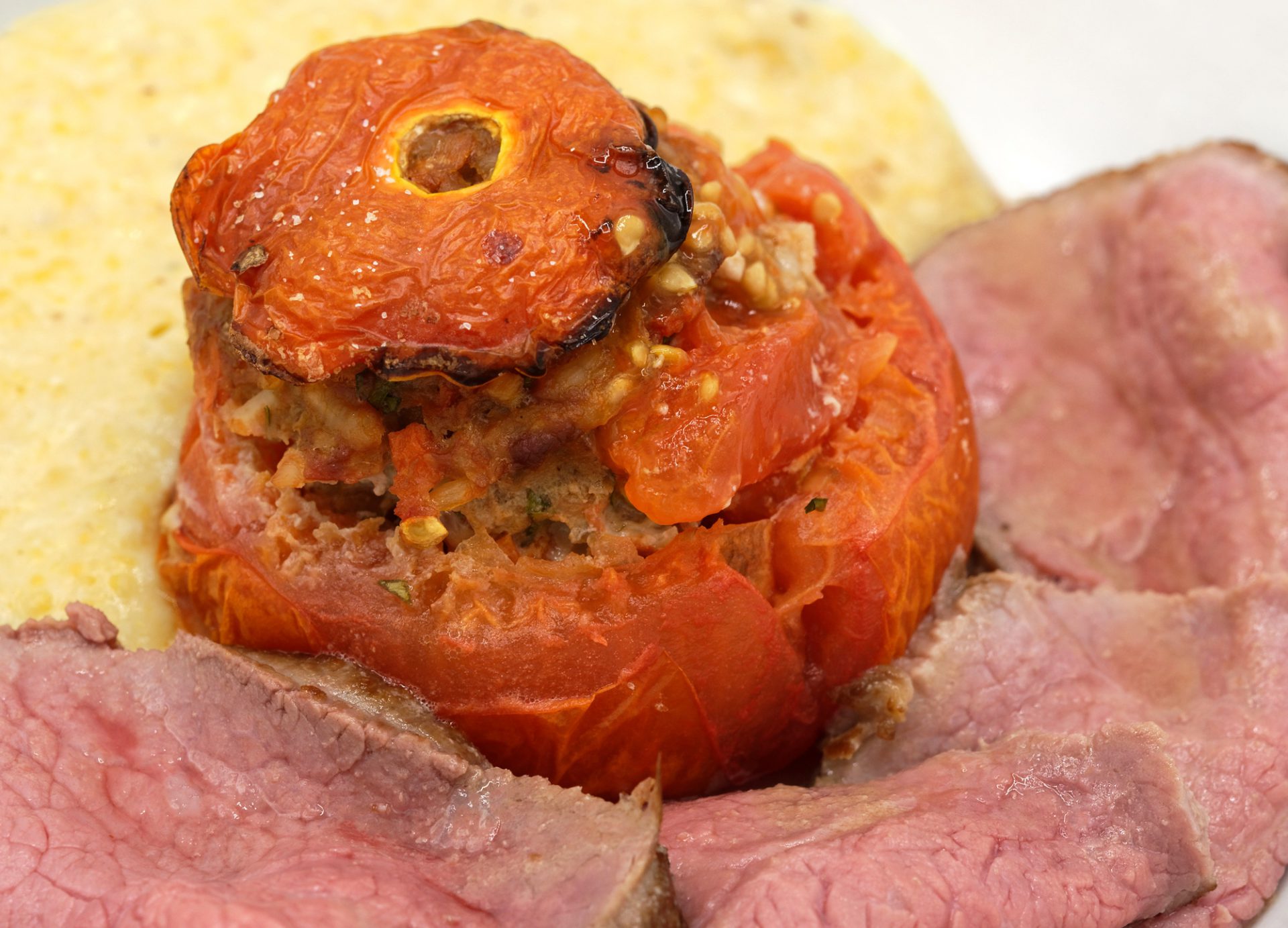It all started with a dish I tried at Jezero, Plantaže‘s restaurant on Lake Skadar in Montenegro. During the tasting menu that followed our epic visit of the winery, the chef served us a beef tenderloin roast with mashed potatoes and a carob-blackberry sauce, which was paired with one of Plantaže’s excellent reds, the Vranac Reserve. (In case you wonder, the two M’s on the plate pictured below are the shared initials of the chef, Mladen, and the head sommelier, Miroslav.) While not necessarily the most inventive dish – after all, it’s another variation on steak and potatoes – I liked the sauce and its use of carob. My task was then to change the recipe into something new that I’d post on this blog. So my mind started wandering… A LOT.
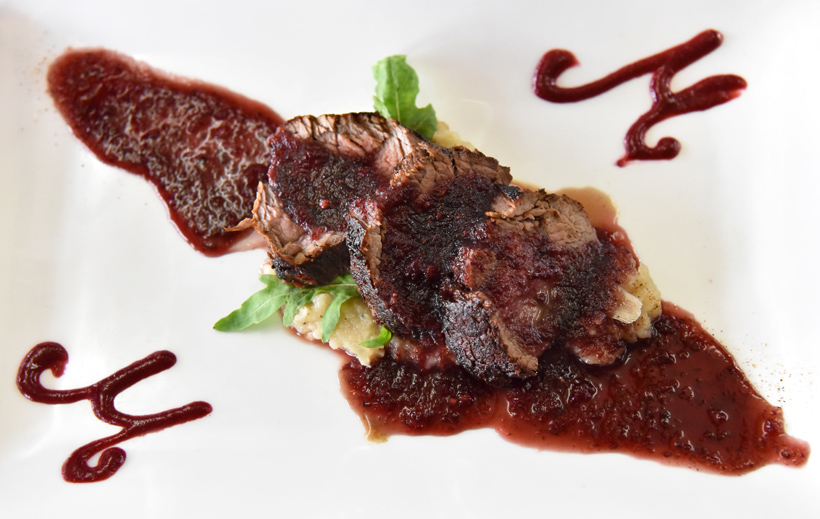
First, I didn’t want to make another potato purée (I did a Russian tomahawk with aligot less than a year and a half ago), so I borrowed the side from another dish I had at Jezero: cicvara. A kind of polenta with farmer cheese and kajmak, cicvara was traditionally prepared in a cauldron above the hearth and was often served for breakfast before days of hard work. The dish seems to be falling into oblivion, and you won’t find too many hits on the web. The recipes out there include similar ingredient amounts and cooking methods. Mine isn’t very different, though it’s a bit thinner since I’m not about to head out for a day of hard work. What a great coincidence that I just published a kajmak recipe, wink-wink! Check out this video to see the whole preparation (sparkling water optional):
Then the beef. Tenderloin/filet mignon is a cut that’s often poo-pooed by chefs. Just consider this: in a recent Thrillist article, out of the fifteen chefs interviewed (though none of them exactly world-class authorities), eleven named it as the most overrated beef cut. And all of them repeat in unison: “no fat”, “no flavor”, “no texture.” They do admit its extreme tenderness, but apparently that’s not enough to make the cut.
I don’t agree with this judgment. I think the unrivaled tenderness of beef tenderloin makes it worth seeking as an occasional change from the usual porterhouse, ribeye, or New York strip. And even if it has a pretty mild flavor, it’s still recognizably beef. But in a diplomatic effort rather unusual for me, I set out on a quest to find other cuts which, prepared properly, would produce a roast nearly as tender as tenderloin, but more flavorful (and inevitably cheaper).
It turns out there’s a cut that’s exactly right. The petite tender, aka shoulder tender, aka teres major, comes from the shoulder blade but is rarely sold as an individual muscle, as it requires some skill to extract from the shoulder clod. A very close second to tenderloin in terms of tenderness, though smaller in size, it can be prepared the same way and offers a deeper beef taste, all for about a third of the price – more details here. Incidentally, only one of Thrillist’s fifteen chefs mentions it!
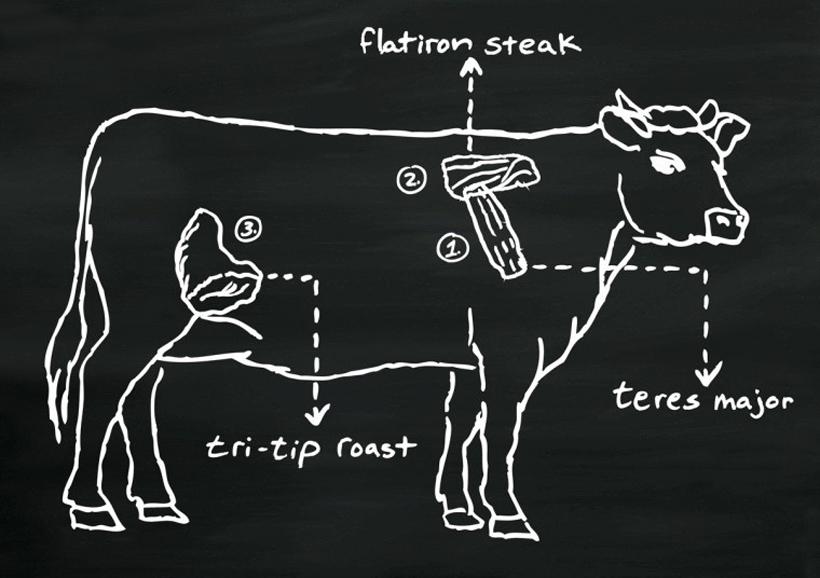
But! While the shoulder tender would work great in today’s recipe, that’s not the cut I’ve chosen. Following many trials, I’ve decided to work with an even more humble cut: the eye of round, which is often used for roast beef at the deli. Lean and flavorful, located somewhere in the middle of the round (i.e., the butt), its rather large size makes for a beautiful roast on the carving board, and when cooked properly and sliced thin, it can be quite tender (though granted, it is no tenderloin).
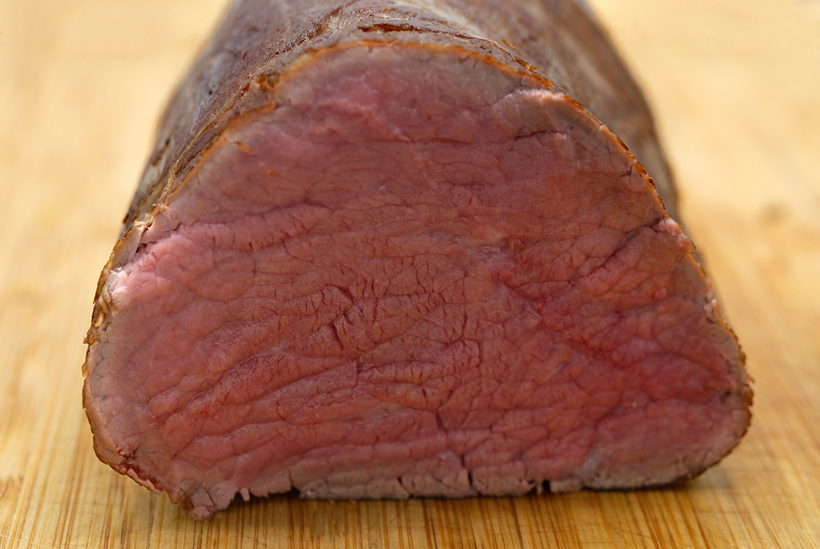
Every steak and potato dish could use more vegetables, and I just so happened to have stuffed tomatoes on my mind. Stuffed peppers are a traditional Balkan dish, the peppers filled with a mix of rice and meat, like in this Serbian recipe. Here, however, the goal isn’t to add more meat to our beef roast, so my ingredients include only a touch of meat, with a lot of vegetables and rice. Plus, the cooking liquid from the tomatoes goes perfectly with the cicvara.
So it turns out I’ve replaced every ingredient of the original dish. We’ve gone from a beef tenderloin roast with mashed potatoes and carob-blackberry sauce to a beef eye of round roast with stuffed tomato and cicvara! We’ll have to keep the original blackberry-carob sauce idea in mind for some other time.
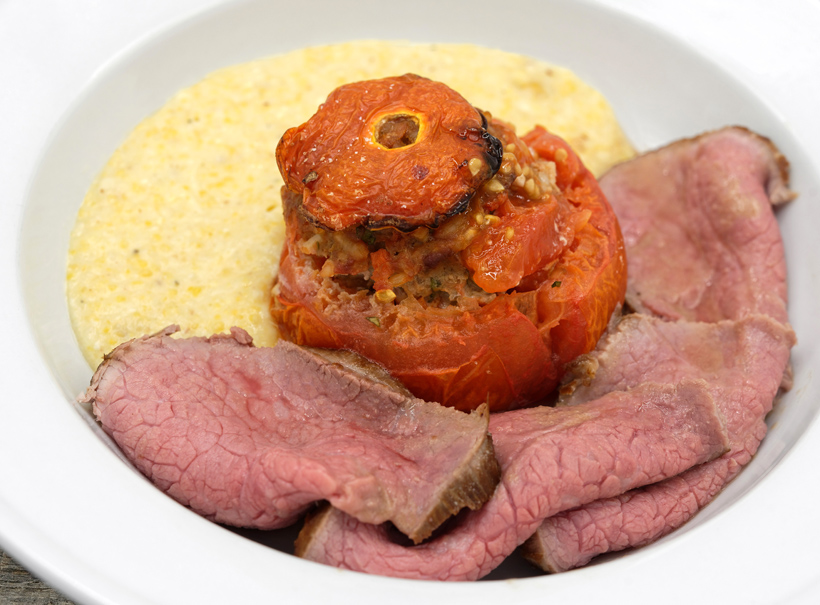
Beef Roast
Yields about 4 servings
600 g beef eye of round roast, fat removed
about 6 g salt (see below)
10 g canola oil
15 g butter
- Tie the beef roast with butchers twine. Measure 1% of the meat’s weight in salt, season the roast with half of that amount, and reserve the rest.
- Heat the canola oil in a pan over very high heat. Sear the beef in the oil until brown on all sides, then transfer to a cutting board and let rest for a minute. Season with the remaining salt, transfer to a sous-vide with the butter, and vacuum-seal. Cook in a 49 C / 120 F water bath for 12 hours.
- Open the sous-vide pouch to collect the jus in a plastic container (I got about 55 g), and reserve to make the sauce. Reseal the pouch and reserve. You can make the roast the day before and refrigerate it.
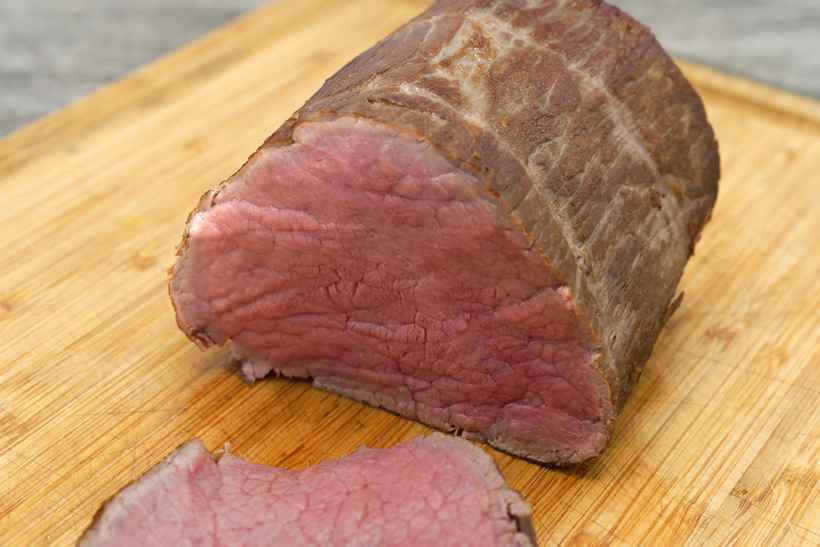
Stuffed tomatoes
Yields 4 servings
100 g vegetable stock
50 g long-grain American white rice (such as Carolina Gold)
15 g olive oil
50 g white wine
65 g peeled onion, small dice
6 g peeled garlic, minced
100 g peeled carrot, small dice
160 g ground pork and beef blend
40 g tomato purée
40 g egg, beaten
7 g parsley, finely chopped
3.5 g salt
3 g smoked paprika
4 medium-large tomatoes, 800-850 g total
- Heat the vegetable stock to a simmer in the microwave, and reserve.
- In a small saucepan over medium heat, cook the rice in 1/4 of the olive oil for a couple minutes, until it starts to become opaque. Add the white wine, and reduce by about 3/4, stirring regularly.
- Add half of the vegetable stock to the rice, cover, and simmer over low heat until fully absorbed. Repeat with the remaining stock, then remove from the heat and reserve.
- In a small pan over medium heat, sauté the onion, garlic, and carrot in the remaining oil until soft. Reserve.
- If you do not plan to cook the stuffed tomatoes immediately, refrigerate the rice and vegetables until cold. Otherwise, proceed to the next step immediately.

- In a bowl, add the rice, vegetables, ground meat, tomato purée, egg, parsley, salt (minus one pinch) and paprika. Combine well using a spatula.
- Cut off the top of each tomato. Scoop out the inside flesh and seeds and coarsely chop, then transfer to a 20 cm x 20 cm square oven dish. Fill each hollow tomato with the rice-and-meat stuffing, using a spoon to pack it well, and cover with a top. (You might have some extra stuffing left.) Place the tomatoes into the oven dish, season the whole dish with the remaining pinch of salt, then cook in a 230 C / 450 F oven for 40-45 minutes, until the center of the stuffing reaches a temperature of 75 C / 170 F. Take out of the oven and keep warm.
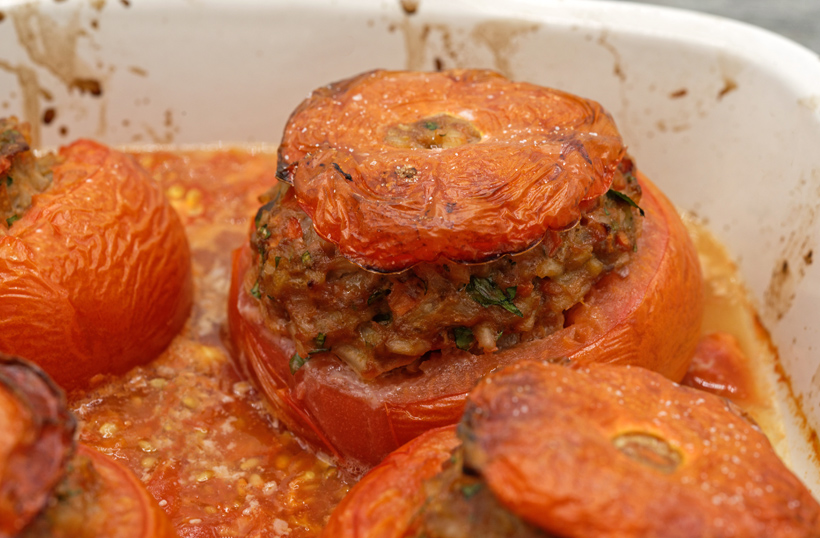
Cicvara
Yields 4 servings
150 g milk
150 g farmer cheese
200 g water
60 g coarse cornmeal (polenta)
150 g kajmak, crumbled
salt
- In a small saucepan over medium heat, bring the milk, farmer cheese, and 3/4 of the water to a simmer, stirring regularly.
- Add the cornmeal, bring to a simmer over medium heat, and cook for about 5 minutes, stirring constantly, until it no longer looks like grains floating in liquid.
- Reduce the heat to very low and cook until the grains are soft, stirring frequently. “Instant” polentas claim they’re ready in 10 minutes or less, whereas Anson Mills polentas, for example, require 45-60 minutes. Just keep in mind that even if most of the liquid has been absorbed, it takes time for the grains to soften throughout.
- Add the crumbled kajmak, and rectify the seasoning with salt if needed. Add the remaining water so that the mixture looks thick yet still liquid enough to spread across a dish when you shake it, a bit like a good risotto (you may need to adjust the exact amount of water required). Cook for a couple minutes, stirring regularly, then proceed with assembly.
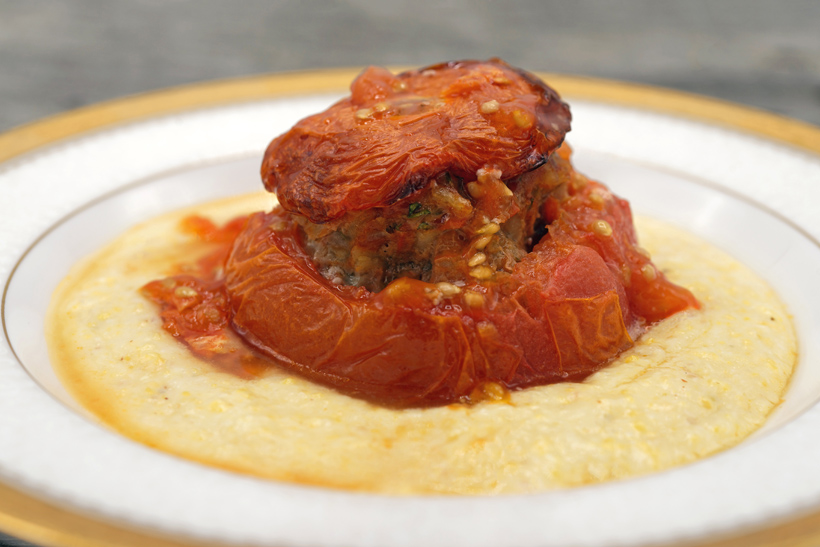
Assembly
Yields 4 servings
sous-vide beef roast and jus
55 g beef stock
35 g butter
10 g canola oil
black pepper, ground
stuffed tomatoes
cicvara
- Reheat the beef roast in its pouch in a 49 C / 120 F water bath, if needed.
- In a small saucepan over high heat, bring the meat jus and beef stock to a simmer. Mix in the butter, then pass through a chinois. Return the sauce to a clean saucepan and keep warm.
- Take the roast out of its pouch, and remove the twine. Heat the canola oil in a pan over very high heat, and briefly sear the meat on all sides to give some more color. Season with black pepper, and reserve.
- Slice the beef very thinly (about 0.25 cm thick). Quickly dip the slices in the sauce, then take them out.
- In a bowl, place a stuffed tomato in the center, and pour some cooking liquid from the dish on top. Arrange a few slices of meat on one side, and a couple spoonfuls of cicvara on the other.
- Or, cover the bottom of a small bowl with cicvara, then place a stuffed tomato in the center, and pour some cooking liquid from the dish on top. On a separate small plate, stack a few beef slices, folded in half, and hold them together using a cocktail skewer.
